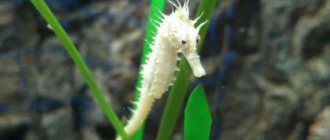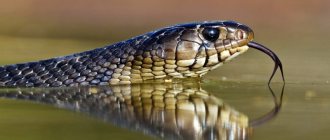The fur seal is in no way related to cats and is a pinniped mammal, a member of the eared seal family. Its closest relative is the sea lion. In nature, there are 7-9 species of fur seals, which are combined into two genera - northern (one species) and southern fur seals (other species).
Origin of the species and description
Photo: Navy SEAL
Fur seals belong to the eared seal family. These are pinnipeds of predators that lead both a terrestrial and aquatic lifestyle. Pinnipeds are distinguished from other families by the structure of their flippers and skull, which is close in shape to that of a bear.
There are several types of fur seals:
- northern (Far Eastern) fur seal. The most common species inhabiting the Pacific Ocean;
- South American fur seal. Includes two subspecies, slightly different from each other: Arctocephalus australis gracilis and Falkland fur seal;
- New Zealand fur seal. Gray-brown fur seals, the males of which have a thick mane;
- Galapagos fur seal. The smallest species;
- Kerguelen fur seal. They are distinguished by patches of gray or gray hair;
- Cape fur seal. Large individuals with velvety red fur;
- Guadalupe fur seal. This species has the most noticeable sexual dimorphism: males are much larger than females;
- subtropical fur seal. Large representatives of the family with thick fur.
The evolution of pinnipeds is peculiar and has many questions. Like whales, these animals first left the ocean to live on land during their evolution. The ancestors of fur seals are mustelids, which led both terrestrial and aquatic lifestyles.
Mustelids fed primarily from the ocean, since they could not run fast and did not have various means of self-defense against large land-based predators. This forced the first mammals to constantly descend to depth. Evolutionarily, they first acquired the ability to hold their breath for a long time, and then they developed a membrane between their fingers.
The intermediate species found indicate that predatory mammals are the second wave of animals that returned to the ocean after whales. The toes on their paws stretched out and became overgrown with a dense membrane, which eventually became flippers. Fur seals, judging by the structure of their hind flippers, are closest to the primitive land forms of life that later went into the water.
Appearance and features
Photo: Fur seal in nature
The size of fur seals varies depending on the subspecies. The largest representatives (Cape and Far Eastern) reach a length of two and a half meters and weigh about 200 kg. The smallest representatives of fur seals (Galapogos fur seal) reach a length of one and a half meters, weight ranges from 60-80 kg in males. Females, as a rule, are much smaller than males - all species of fur seals exhibit sexual dimorphism, but in some it is more pronounced.
Interesting fact: To distinguish a fur seal from a seal, just pay attention to their ears - they should be clearly defined and, as a rule, covered with fur.
The body of fur seals is elongated, the neck is short, thick, and inactive. Relative to the body, the head is small and the muzzle is short and sharp. The eyes are black and large; Large, movable nostrils are clearly visible, which close tightly when the seal dives.
Video: Navy SEAL
The front flippers are located on the sides of the body - they are short and flat. The hind flippers are located at the end of the body, they are shorter than the front ones. Unlike the flippers of seals, the rear flippers of fur seals are parallel and do not close together when walking.
Often males have a mane on their neck - a dense thick layer of fur. Its closest relatives, sea lions, have similar fur. Most subspecies of fur seals are completely covered in a dense layer, and this fur was highly valued as a fishery.
Seal pups are black, small, completely covered with dense fur. They move quickly on land thanks to their low weight and relatively long flippers, which shorten with age.
Interesting fact: Fur seals have a tail, but it is short and almost invisible between the two rear flippers.
The weight of female fur seals can vary between 25-60 kg, depending on the species. They do not have thick fur or manes, and their muzzle is shorter than that of males. All fur seals have poor vision, similar to myopia, but at the same time excellent hearing and sense of smell. They have the ability to echolocate, so they can detect predators underwater.
Now you know the difference between a fur seal and a seal. Let's find out where this amazing animal lives.
Excellent swimmers
Although fur seals breathe air, they thrive in water. They often remain at sea for several months. Many species of fur seals can remain underwater for more than 10 minutes without surfacing. Some individuals dive to depths of up to 245 meters. However, on average these mammals dive to approximately 30 meters depth. People can dive without scuba gear only to 6-12 meters.
Fur seals have a thick layer of fat under their skin that helps them swim. It also acts as insulation. Along with fur, it protects them from the cold temperatures of the ocean.
Despite their large size, fur seals can swim at speeds of up to 24 km/h. For comparison, Olympic swimmer Michael Phelps' top speed is about 10 km/h.
Where does the fur seal live?
Photo: Navy SEAL in Russia
Fur seals choose islands and coasts as habitats, where they settle in large flocks. They live only near salt water and are not found in inland waters such as rivers and lakes. Since fur seals are more adapted to life on land than seals, they choose gently sloping shores, mostly rocky. Sometimes they can be seen on empty rocky islands, where they bask in the sun.
In general, fur seals can be found in the following places:
- California;
- Japan;
- Pacific Islands;
- the coast of South America;
- Falkland Islands;
- New Zealand;
- south and west Australia;
- Galapagos Islands;
- South Georgia Islands;
- South Sandich Islands;
- Prince Edward Islands;
- southern Shetland, Orkney islands;
- Bouvet;
- Kerguelen;
- Hurd;
- Macquarie;
- Bass Strait;
- the coast of the Namib Desert in South Africa;
- South Atlantic and Amsterdam.
Fur seals prefer warm waters. They usually migrate with the onset of cold weather to warmer places, swimming from island to island in large flocks. But in the warmest regions, fur seals can stay all year round. The Kerguelen fur seal is the most adapted to cold climates, as it can be found almost throughout Antarctica, but it leads a migratory lifestyle.
Fur seals choose spacious territories for rookery, do not build houses or dig holes. They are territorial animals, and the territory is jealously guarded by the male, although females can freely cross the boundaries of the flock and come to other rookeries.
Life at the Zoo
Our northern fur seals are a family consisting of a male Pirate, adult females Yushka, Sparta and Dory, as well as their children. They live in the New Territory near the crossing bridge. Their enclosure includes both an outdoor part and large indoor areas where the cats can enter at any time. Often animals specifically swim up to people to communicate. When a cat lies on the water, motionless, and sleeps peacefully, this often frightens vigilant visitors who believe that the animal has died. The seals at the zoo are fed fish and squid. In summer they receive from 4 (females) to 5–6 kg (males) of food per day, and in winter the diet increases by 50%, since the animals are kept outside all year round.
What does a fur seal eat?
Photo: Fur seal from the Red Book
Fur seals are exclusively predators. They come out to feed every day, except when they are raising their young. In the summer, fur seals eat especially a lot in order to accumulate fat in the cold season, when there is not much food.
The daily diet of fur seals includes:
- various fish (mainly herring, anchovy, pike, small sharks, cod, stickleback, flounder);
- frog-like;
- crustaceans;
- valve molluscs;
- octopus, squid, cuttlefish, jellyfish.
Digestion of food in fur seals occurs very intensively, so studies and autopsies of killed animals do not provide an accurate indication of the diet of fur seals. Scientists have discovered that they even eat poisonous jellyfish that float to the rookeries of fur seals.
Various birds - gulls, albatrosses, petrels - often settle near fur seals. They do not show aggression towards their neighbors and do not hunt on land, while relatives of fur seals - seals - can attack birds and small mammals. Sometimes algae is found in the stomachs of fur seals: they probably get there by accident along with fish; however, sometimes you can see fur seals biting the grass in the rookeries.
Interesting fact: Fur seals are indifferent to salmon and halibut - they do not attack these fish at all.
In the water, fur seals are very agile and dangerous predators. They move quickly underwater and catch slow-moving prey, immediately swallowing it whole. The stomach of fur seals contains pebbles that they absorb during feeding - they play the role of a “grater”, helping the stomach cope with solid food.
Nutrition
They feed on fish and squid. They swim tens or even hundreds of kilometers in search of prey. Meager rations are not typical for him. The stomach of an adult male can hold 15-16 kilograms of food. In especially large animals - cleavers - 20 and even 25 kilograms of food were found in the stomach, but this is already rare. Females and young animals are content with less: three to four kilograms is enough for them for a day or even more.
Features of character and lifestyle
Photo: Navy SEALs
Fur seals are schooling animals that build rookeries on coasts and islands. They feed both at night and during the day as they rely on their hearing, smell and echolocation. On the shore, they bask in the sun and rest, digesting food.
They move awkwardly on land, pushing off with their front and rear flippers and swinging their necks back and forth. They are also helped in moving by subcutaneous fat, on which they seem to bounce, pushing off the ground. But fur seals swim excellently, developing speeds from 17 to 26 km per hour.
Northern fur seals regularly migrate with the onset of winter, swimming to warmer regions. There they set up rookeries and rarely feed, losing a lot of weight during the cold period. They return in the spring for the breeding season.
In most cases, fur seals are not aggressive and timid, although there is room for curiosity. Only during the breeding season do males become too aggressive and hardly feed due to constant surveillance of females.
Fur seals are polygamous. The male has a harem of three to forty individuals - the size of the harem depends on the strength of the male and his aggressiveness. He needs to regularly fight off females from other males who also want to form their own harems.
Navy seals do not have any means of self-defense. They are defenseless both on land and in water. Female fur seals are unable to protect their pups, which may be attacked by land-based predators or large birds such as albatrosses. In case of danger, they prefer to run to the water.
Vocalization
The sounds made by fur seals are very diverse, and they are most “talkative” when they are in rookeries on land. Males, demonstrating the occupation of territory and threatening rivals, emit a powerful vibrating roar, reminiscent of a loud siren of a steamship. When regularly patrolling their territory, males emit specific, unusually high-pitched clicking sounds for such large animals. Female cats also communicate with each other. Their rather loud and aggressive “grunting” is constantly heard in rookeries, especially when attempting to violate individual territories. The female communicates with the cub using special soft, gentle cries, and when looking for her cub in the rookery, she emits a loud bleat. The cub, in turn, calls the mother, who has returned to the rookery after feeding, by also bleating loudly. It is by voice (and smell) that females find their cubs at the rookery.
Social structure and reproduction
Photo: Seal pup
The breeding season falls in the spring, but it can be earlier or later, depending on the arrival of heat. Males swim to rookeries - islands and coasts, trying to occupy as large a territory as possible. There they begin the first battles for the right to occupy this or that piece of land. The strongest male occupies a large territory.
Males begin to roar, attracting females to their area. Females move freely between the territories of males, choosing the most suitable place for breeding. If they like the territory, they will stay with that male - so the strongest males take large territories and a large number of females.
Interesting fact: Sometimes a male will try to steal a female from another harem by grabbing her by the scruff of the neck. Moreover, if the “owner” of the female notices this, he will begin to drag her in his direction. Given the difference in size between individuals, the female often receives injuries incompatible with life after such a struggle.
A harem can number up to forty females. During this same period, mating occurs, during which the males begin their fights again, and the females again choose which male to produce offspring from. The female's pregnancy lasts a year, but during it she can mate with other males.
At the first stages of pregnancy, the female is as active as before, but after six months she goes out to feed less often. The closer the birth is, the more time the female spends on the shore, and her body feeds on fat reserves. For about two weeks after giving birth, she stays with the baby and feeds him. A fur seal is born weighing just over two kg, and at first is not able to move independently along the shore.
After two weeks, the female is so exhausted that she is forced to leave the child alone and go hunting. During this period, the fur seal may make its first short swim off the coast while waiting for its mother. Without his mother, he is especially vulnerable because he can easily be simply run over by other seals he happens to be close to.
Interesting fact: A male from another territory can penetrate to females that have given birth to mate with them; To do this, he kills their cubs while the females go hunting.
The mortality rate of young animals is very high. If a female loses her cub in the first two weeks after giving birth, she can become pregnant again, but later cubs rarely survive the onset of cold weather.
Lifestyle
In spring, adult males (from 7 to 11 years old) are the first to swim into bays on sandy or rocky shores. Having examined the area from the water, they get out onto land and “reserve a territory for themselves where his harem will be for 5–6 months. A little later, the females arrive and their conquest begins. Each male recruits from 5 to 20 females into his harem, and the quiet life ends.
Cleaver jealously watches his “concubines” so that they are not lured by their rival to his territory. The leader of the harem has a crest on his head so that everyone knows that I am the master. Single males, up to 6 years old, live in a separate colony, a little further from the harems. Females, coming onto land, approximately two days later, give birth to one calf at a time. Sometimes there are two babies, but this is rare. The newborn's weight is 3 kg, body length is 50 cm, and he is absolutely black.
Babies are fed fatty (up to 70% fat) and nutritious mother's milk. For several weeks, the female does not leave her cub, feeding him. He gains strength, but she needs refreshment, and she goes fishing at sea, leaving him alone for several days. Since many children are born, they, remaining alone on the shore, form a nursery.
Males do not pay any attention to the little ones, and in the fight for the female, they can crush the cub. And the females, a short time after the birth of the cub, mate with the male in order to return here the next year and give birth to offspring. From this we conclude that pregnancy lasts about a year.
Growing up, the cubs play with each other, try to reach the water, and even dive into it. Nobody helps them, they learn everything themselves. In the water they try to somersault, jump and resist the current. Well, the female, returning from the sea, will easily find her baby and feed him. If the female dies, and she has a cub, then he is also doomed to death. No one will feed him - not a single female will let him near her.
In three months, the puppies will have their first molt and will change into beautiful light gray coats. All summer the little cubs grow and get stronger, and very soon, in the fall, they will have to leave the rookery and go to warm seas. But this path is not easy; if he swallows water during a storm, he will die. In a year, the grown cub reaches a weight of 15 kg.
In late autumn, they all leave their rookeries and swim to warm waters for the winter. From October to April, seals live in the water, fattening up, and do not go onto land. These amazing animals will return to land and to their places in the spring. And everything will repeat all over again.
Natural enemies of fur seals
Photo: Little fur seal
The fur seal occupies an important place in the food chain. While it preys on many fish and shellfish, the fur seal is preyed upon by other creatures.
These include:
- orcas. These formidable predators hunt fur seals not only for food, but also for fun. They drive one individual onto a small island and then rush out onto it, grabbing the prey. Killer whales can sometimes be seen tossing fur seals into the air and catching them;
- sharks, including great whites. Sharks are fast in pursuit of fur seals, and they are often slower than large fish;
- baby fur seals are attacked by albatrosses, petrels, and cormorants - small fur seals are defenseless against large birds.
When a fur seal is attacked by a shark or killer whale, the first thing it does is try to swim away, reaching speeds of up to 26 km per hour. Sometimes this is enough to get to the nearest shore and get to land, although some sharks and killer whales wash ashore after them. Sometimes this plays a cruel joke on white sharks, which are unable to return back to the water, so they die along with the fur seal in their teeth.
Habitat
The entire population of these animals on the planet is divided into Northern fur seals and Southern fur seals. Their habitat is the Pacific Ocean, from the Alaska Peninsula in the north to Australia in the south. In addition, one of the species of these animals lives on the coast of the southern part of the African continent. The fur seal prefers the coast, and can be located both on a rocky shore and in flat areas.
Fur seals are herd animals, they gather in huge colonies and all settle in one place. Sometimes in places where such a concentration of cats live, there is literally nowhere for an apple to fall. The shore is a resting place for these mammals, and hunting takes place in the water. Often, the hunt is protracted – up to three days. But this is not a problem for fur seals, because they can even sleep in the water!
These mammals are migratory animals. Their movements are associated with breeding, because during the breeding season they require cold waters, which contain a lot of the food they need. Although fur seals live in herds, each one prefers to hunt on his own, that’s their nature! Scientists believe that these representatives of pinnipeds have fairly high intelligence.
In our country there are three separate herds of fur seals - Komandorskoye, Kurilskoye, Sakhalinskoye. In the United States, the largest group is located on the Pribilof Islands, which in some years reaches several million individuals. Another species lives in the southern hemisphere - the southern fur seal, whose fur is significantly inferior in quality to its northern counterpart.
Population and species status
Photo: Fur seal in the water
In the 18th century, the fur seal population was a commercial target. People rapidly exterminated fur seal pups for their soft fur and valuable fat, which is why, over two centuries, fur seals reached a critical population level, finding themselves on the verge of extinction.
The measures taken to protect the seals were not effective, and they could have gone completely extinct if the number of fur seal skins on the market had not been too large, causing them to fall in price. The fur seal hunt was ended due to lack of profit.
The ban on fur seal fishing has led to an increase in the population. An extremely large number of fur seals are observed on the island of South Georgia, where there are more than two million individuals. Most subspecies of fur seals are in a stable position in terms of numbers, but there are exceptions.
Fur seals get along well with people in captivity. They are trainable and a non-aggressive species that is safe to interact with, unlike seals and sea lions. In zoos and aquariums, fur seals are fed dead fish - herring and anchovy.
Fur
Fur with a well-developed undercoat is of great importance for these seals, in contrast to sea lions, whose fur is sparser, and in which the main thermal insulation function is performed by fat. The color of the guard hairs differs sharply from the color of the underfur, but the underfur is almost completely hidden under the guard hairs.
Coat color varies among animals of different ages and sexes. Newborns have a uniform dark color; albinos and chromists are quite rarely born, but these cases are quite rare, and per hundred thousand newborns there is one with a changed color. Since albinism is associated with the manifestation of recessive genes, such puppies also have other changes and, in particular, they are practically blind. It is likely that such animals are not viable, since not a single sighting of an adult albino has been recorded.
After the first moult (at the age of 3-4 months), the overall color background of the seals' fur acquires a gray tonality. Because of this fur, these animals were once hunted. Subsequently, the fur of these animals changes differently in males and females. As adults, male seals have a darker color; with age, more light (gray) hair appears in the coat of males. Females retain silvery coats, but their fur turns slightly yellow as they age.
The fur of fur seals performs a number of important functions: it provides thermal insulation (air is retained in the undercoat) and takes on a hydrodynamic function. They accumulate subcutaneous fat in relatively small quantities, which allows them to dive deeply.











